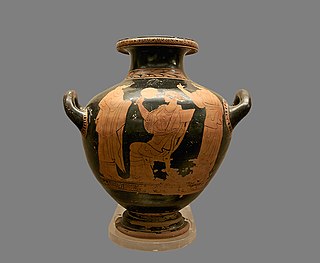See also
| This disambiguation page lists articles associated with the title Askos. If an internal link led you here, you may wish to change the link to point directly to the intended article. |
Askos may refer to:
| This disambiguation page lists articles associated with the title Askos. If an internal link led you here, you may wish to change the link to point directly to the intended article. |

Pottery is the process and the products of forming vessels and other objects with clay and other ceramic materials, which are fired at high temperatures to give them a hard, durable form. Major types include earthenware, stoneware and porcelain. The place where such wares are made by a potter is also called a pottery. The definition of pottery used by the American Society for Testing and Materials (ASTM), is "all fired ceramic wares that contain clay when formed, except technical, structural, and refractory products." In archaeology, especially of ancient and prehistoric periods, "pottery" often means vessels only, and figures etc. of the same material are called "terracottas". Clay as a part of the materials used is required by some definitions of pottery, but this is dubious.

Sozopol is an ancient seaside town located 35 km south of Burgas on the southern Bulgarian Black Sea Coast. Today it is one of the major seaside resorts in the country, known for the Apollonia art and film festival that is named after one of the town's ancient names.

Ancient Greek pottery, due to its relative durability, comprises a large part of the archaeological record of ancient Greece, and since there is so much of it, it has exerted a disproportionately large influence on our understanding of Greek society. The shards of pots discarded or buried in the 1st millennium BC are still the best guide available to understand the customary life and mind of the ancient Greeks. There were several vessels produced locally for everyday and kitchen use, yet finer pottery from regions such as Attica was imported by other civilizations throughout the Mediterranean, such as the Etruscans in Italy. There were various specific regional varieties, such as the South Italian ancient Greek pottery.

Red-figure vase painting is one of the most important styles of figural Greek vase painting.

Dankiyo, is an ancient word from the text of Evliya Çelebi (17th century, Ottoman Era "The Laz's of Trebizond invented a bagpipe called a dankiyo..." describing the Pontian tulum, a type of bagpipe which the ancient Greeks called an askaulos. It consists of a lamb skin, a blow pipe, and the double reed chanter.

The Gandhara grave culture, also called Swat culture, or Swat Protohistoric Graveyards Complex, emerged c. 1400 BCE and lasted until 800 BCE, and there are no burials with these features after 800 BCE, as new fieldwork reveals. It is found basically in Middle Swat River course, even though earlier research considered it to be expanded to the Valleys of Dir, Kunar, Chitral, and Peshawar. It has been regarded as a token of the Indo-Aryan migrations, but has also been explained by local cultural continuity. Backwards projections, based on ancient DNA analyses, suggest ancestors of Swat culture people mixed with a population coming from Inner Asia Mountain Corridor, which carried Steppe ancestry, sometime between 1900 and 1500 BCE.

The hydria is a form of Greek pottery that existed between the Late Geometric Period and the Hellenistic period. The etymology of the word hydria was first noted when it was stamped on a hydria itself, its direct translation meaning ‘jug’.

A loutrophoros is a distinctive type of Greek pottery vessel characterized by an elongated neck with two handles. The loutrophoros was used to carry water for a bride's pre-nuptial ritual bath, and in funeral rituals, and was placed in the tombs of the unmarried. The loutrophoros itself is a motif for Greek tombstones, either as a relief or as a stone vessel. There are many in the funeral area at the Kerameikon in Athens, some of which are now preserved in the National Archaeological Museum of Athens.

An alabastron or alabastrum is a small type of pottery or glass vessel used in the ancient world for holding oil, especially perfume or massage oils. They originated around the 11th century BC in ancient Egypt as containers carved from alabaster – hence the name – but spread via ancient Greece to other parts of the classical world.

The Yaz culture was an early Iron Age culture of Margiana, Bactria and Sogdia, or. It emerges at the top of late Bronze Age sites (BMAC), sometimes as stone towers and sizeable houses associated with irrigation systems. Ceramics were mostly hand-made, but there was increasing use of wheel-thrown ware. There have been found bronze or iron arrowheads, also iron sickles or carpet knives among other artifacts.
Geometric art is a phase of Greek art, characterized largely by geometric motifs in vase painting, that flourished towards the end of the Greek Dark Ages, circa 900 BC – 700 BC. Its center was in Athens, and from there the style spread among the trading cities of the Aegean. The Greek Dark Ages are also called the Geometric period in reference to this characteristic pottery style, although the historical period is much longer than the art-historical period, being circa 1100 – 800 BC. The vases had various uses or purposes within Greek society, including, but not limited to, funerary vases and symposium vases.

The pottery of ancient Greece has a long history and the form of Greek vase shapes has had a continuous evolution from Minoan pottery down to the Hellenistic era. As Gisela Richter puts it, the forms of these vases find their "happiest expression" in the 5th and 6th centuries BC, yet it has been possible to date vases thanks to the variation in a form’s shape over time, a fact particularly useful when dating unpainted or plain black-gloss ware.

Bucchero is a class of ceramics produced in central Italy by the region's pre-Roman Etruscan population. This Italian word is derived from the Latin poculum, a drinking-vessel, perhaps through the Spanish búcaro, or the Portuguese púcaro.

Askos is the name given in modern terminology to a type of ancient Greek pottery vessel used to pour small quantities of liquids such as oil. It is recognisable from its flat shape and a spout at one or both ends that could also be used as a handle. They were usually painted decoratively like vases and were mainly used for storing oil and refilling oil lamps.

Apulian vase painting was a regional style of South Italian vase painting from ancient Apulia. It comprises geometric pottery and red figure pottery.

In the typology of ancient Greek pottery, the kernos is a pottery ring or stone tray to which are attached several small vessels for holding offerings. Its unusual design is described in literary sources, which also list the ritual ingredients it might contain. The kernos was used primarily in the cults of Demeter and Kore, and of Cybele and Attis.

Daunian pottery was produced in the Daunia, today's Italian provinces of Barletta and Foggia. It was created by the Daunians, a tribe of the Iapygian civilization who had come from Illyria.

Three-phase firing or iron reduction technique is a firing technique used in ancient Greek pottery production, specifically for painted vases. Already vessels from the Bronze Age feature the colouring typical of the technique, with yellow, orange or red clay and brown or red decoration. By the 7th century BC, the process was perfected in mainland Greece enabling the production of extremely shiny black-slipped surfaces, which led to the development of the black-figure and red-figure techniques, which dominated Greek vase painting until about 300 BC.

Ancient Greek art stands out among that of other ancient cultures for its development of naturalistic but idealized depictions of the human body, in which largely nude male figures were generally the focus of innovation. The rate of stylistic development between about 750 and 300 BC was remarkable by ancient standards, and in surviving works is best seen in sculpture. There were important innovations in painting, which have to be essentially reconstructed due to the lack of original survivals of quality, other than the distinct field of painted pottery.
The conservation and restoration of Ancient Greek pottery is a sub-section of the broader topic of conservation and restoration of ceramic objects. Ancient Greek pottery is one of the most commonly found types of artifacts from the ancient Greek world. The information learned from vase paintings forms the foundation of modern knowledge of ancient Greek art and culture. Most ancient Greek pottery is terracotta, a type of earthenware ceramic, dating from the 11th century BCE through the 1st century CE. The objects are usually excavated from archaeological sites in broken pieces, or shards, and then reassembled. Some have been discovered intact in tombs. Professional conservator-restorers, often in collaboration with curators and conservation scientists, undertake the conservation-restoration of ancient Greek pottery.